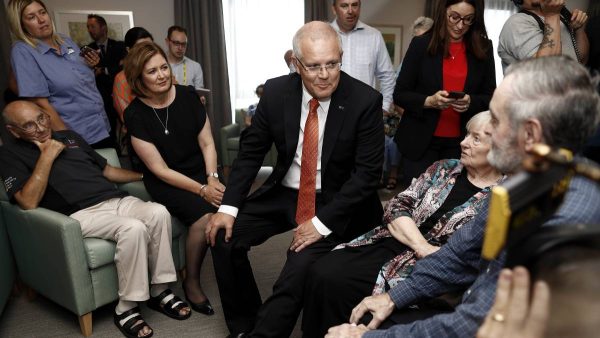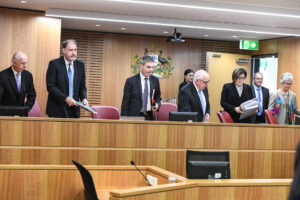
Aged care was in crisis long before the pandemic arrived on Australian shores, yet even more than 500 deaths in one month is apparently not enough to make it a greater priority than attending the cricket for the Aged Care Services Minister. How good is Australia?
It’s not that long since the royal commission delivered a scathing report that described Australia’s aged care system as “a shocking tale of neglect”. Now more than 500 – that’s 500 – aged care residents have died from COVID this year. It’s only February. More aged care residents died of COVID in January than in the whole of 2021. They are more than numbers. They are our parents, our grandparents, our friends.
To combat the unfolding disaster, several ministers were sent in to bat. When he finally decided to appear before the Senate’s COVID committee, after initially declining to attend in favour of watching the cricket, Aged Care Services Minister Richard Colbeck was stumped by a question about how many residents had died before they had gotten their booster shot, the rollout of which was supposed to be finished by the end of January. Defending Colbeck’s Ashes attendance, Finance Minister Simon Birmingham reassured the public that Colbeck could “walk and chew gum at the same time”. Under questioning about the speed of the booster rollout, Health Minister Greg Hunt very kindly urged families to consent to their booster shots on the ABC’s RN Breakfast.
Meanwhile, residents and their loved ones have reported that people have been locked in their rooms, sometimes going without meals and medications, as the already struggling industry has tried to cope with the Omicron wave. Something like 15,000 residents have been infected with COVID, and more than 10,000 aged care workers, too. This is the squalid state of affairs for the most vulnerable cohort of Australians, the people who are supposedly the government’s number-one priority.
As news broke that almost one-quarter of Australia’s aged care shifts go unfilled each week, with even more vacancies in the disability sector, the Prime Minister announced that aged care workers would be eligible for up to two one-off $400 bonus payments. Offering an $800 bonus payment to aged care workers right now is a bit like offering firefighters a bucket of water each during the Black Summer bushfires. Nothing was offered to workers in the disability sector.
Over a year ago, the royal commission identified the need for better wages in the sector. Employers and unions even reached consensus on the need to boost wages in recognition of this chronically undervalued work. The Health Services Union and the Australian Nursing and Midwifery Federation currently have a case before the Fair Work Commission, where they are arguing for a 25 per cent pay increase for residential and aged care workers. So far the government has not made a submission in support of the pay increase, and at least one minister has indicated the government will not support it.
“A $5 per hour increase would dramatically increase the cost of the aged care workforce, and we want to make sure this is a sustainable system going into the future,” the Minister for Superannuation, Jane Hume, said this week. Funny how a pay increase for aged care workers is “unsustainable”, but somehow the $184 billion in income tax cuts for high-income earners, due to start in 2024, are still completely affordable.
Securing a pay rise for aged care workers is probably the most urgent priority in Australia, but the reality is that Australia has had a crisis in wages growth for many years. It’s so bad even the Reserve Bank keeps talking about the need for wages growth. As company profits have continued to soar, labour’s share of growth has diminished – meaning workers are missing out and wages aren’t keeping up with the rising costs of living.
As Jim Stanford, economist and director of the Australia Institute Centre for Future Work, says, there are many structural barriers to wages growth – none of which the federal government is interested in removing.
“To get higher wages, we need stronger minimum wages, more collective bargaining, and an end to wage freezes and caps in the public sector. We also need to create more stable, secure jobs, in which workers have more confidence to ask for a wage increase. That can’t happen in casual or temporary jobs, where workers have no stability and no bargaining power,” Stanford says.
Underpinning much of this is the rampant spread of insecure work. It’s partly the reason why COVID has so easily spread in aged care, as casual workers are forced to work across multiple facilities to put food on the table. It’s also why thousands of aged care workers won’t be eligible for the full $800 bonus payment, as many of them work multiple shifts outside the sector to care for people with disabilities and the veteran community as well.
At the National Press Club this week, the Prime Minister was asked what he would do differently with the benefit of hindsight. His response was telling: he said he would have put the vaccine rollout in the hands of the military “from the outset”. The fact the federal Health Department was incapable of managing a vaccine rollout during a global pandemic, after almost a decade of Coalition government, is apparently of no concern to him.
Opposition Leader Anthony Albanese has called for Richard Colbeck to resign or be sacked. But this government rarely believes in personal responsibility when it comes to cabinet ministers.
It was only a few weeks ago the PM was bragging that Australia was “taking wickets in the virus”, while his Aged Care Services Minister trod on his own wicket. But after a disastrous summer and the latest polling results, voters may be waiting on their verandahs with their proverbial cricket bats.
Between the Lines Newsletter
The biggest stories and the best analysis from the team at the Australia Institute, delivered to your inbox every fortnight.
You might also like
If business groups had their way, workers on the minimum wage would now be $160 a week worse off
Had the Fair Work Commission taken the advice of business groups, Australia lowest paid would now earn $160 less a week.
5 ways and 63 billion reasons to improve Australia’s tax system
With a federal election just around the corner, new analysis from The Australia Institute reveals 63 billion reasons why our next Parliament should improve the nation’s tax system.
The continuing irrelevance of minimum wages to future inflation
Minimum and award wages should grow by 5 to 9 per cent this year


